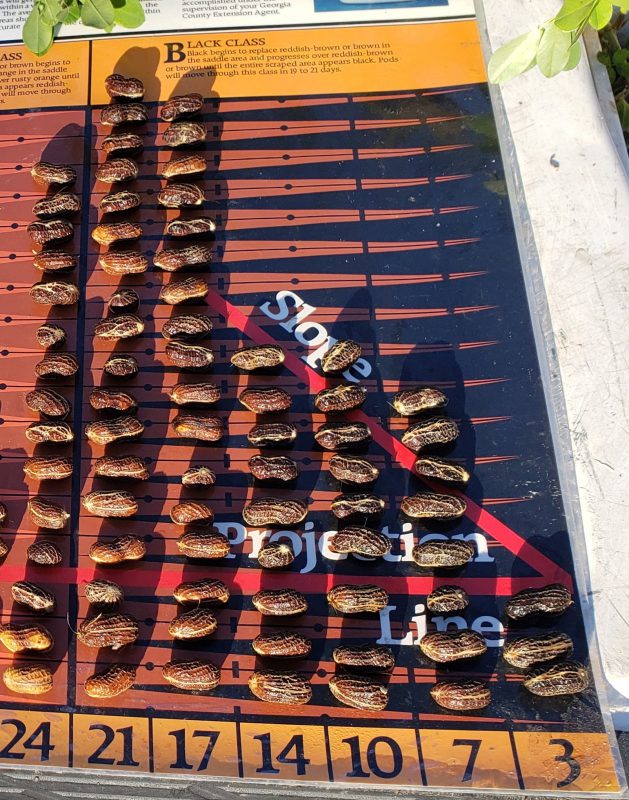Mark Mauldin, Ag & Natural Resources Agent Washington County, Dr. Barry Tillman, Peanut Breeder UF/IFAS NFREC, Ethan Carter, Regional Row Crop IPM Agent, and Camila Ichazo

The rains over the past two weeks have been more scattered with totals ranging from 1 to 10 inches across the peanut producing region of Florida. With harvest season in full tilt, everyone is welcoming the drier conditions that arrived over the past few days. https://water.weather.gov/precip/
The persistently wet conditions throughout the growing season have really started catching up to some fields in the last couple of weeks. Favorable conditions for fungal growth combined with too-wet-to-work soils delaying fungicide applications have resulted in high levels of disease pressure as we near harvest. The following are some comments from Dr. Bob Kemerait, UGA Plant Pathology Extension Specialist, regarding the current situation in Georgia. Many Florida fields are in the same situation.
The “story”, at least in many peanut fields in Georgia right now, is all about “leaf spot”, primarily “late leaf spot”. Late leaf spot, more so than ever before in my career, has exploded.
- We are NOT seeing a collapse of our fungicides or our active ingredients. We at UGA have too many trials out across the state to prove our chemistries and programs, while not bullet-proof, are holding.
- It has been a PERFECT year for leaf spot epidemics.
- We have had beaucoup rain that enhances infection by leaf spot pathogens and spread of leaf spot diseases.
- Wet weather has led to extended delays between fungicide applications and even missed applications.
- We have had shortages on many fungicides resulting in use of something other than what we really wanted.
- Many of our newer peanut varieties likely need an 8th fungicide application because of our extended growing season.
- Delays in planting mean that much of our crop is still in the field when pressure from leaf spot is INTENSE and BLISTERING.
- Some of our newer peanut varieties are more susceptible to leaf spot than is Georgia-06G.
- What to do? If you are two-three weeks out from digging, assess your field for disease.
- If leaf spot is not a problem (nor is white mold) then you may not need the sprayer in the field again.
- If leaf spot is in the field and not too severe, you might consider one last application.
- If you have lost 25% of your leaves, anticipate digging within two weeks, regardless of maturity.
- If you have lost 50%, you have a week to 10 days max.
- If you have lost 75% or more – dig immediately, as the pods are likely dropping off now.

Some Washington County peanuts that have had all they can take. Wet conditions prevented timely fungicide application resulting in severe defoliation across the field. These peanuts will be harvested as soon as conditions allow. Photo Credit: Mark Mauldin, UF/IFAS
The cooler, dryer weather that is expected to persist for the next week or so should help to slow the spread of diseases, especially white mold. However, if you have fields that have already been defoliated by leaf spot please take the guidelines listed above under advisement. As important as it is to optimize harvest timing based on the physiological maturity of the crop, see the Tracker below, the condition of the vines may now be in the driver’s seat for setting harvest timing for some fields.
aGDD Tracker for the Florida Peanut Producing Region – 9/24/21 edition
The aGDD Tracker is compiled from data generated by PeanutFARM.org. The dark blue bars in the cells with the aGDD values indicates progress towards 2500 aGDDs. The bar extends to the right as aGDDs are accumulated. The entire cell will be dark blue when a field has accumulated 2500 aGDDs. It is recommended that fields be sampled and exact days-to-harvest be determined via pod-blasting once a field reaches 2300 aGDDs.
If you have fields that are approaching 2300 aGDDs, contact your County Extension Office and make arrangements to have samples pod-blasted and analyzed. Over the past two weeks, across all locations, fields accumulated approximately 125 aGDDs each week (down from 136 and145 during the two previous two week periods), so plan accordingly. The declining rate of accumulation is expected as the days continue to shorten and temperatures cool. Remember, that the information generated will only be as good as the sample provided. Collect a good representative sample; dig (don’t pull) plants from several locations throughout the field, avoiding field edges and the ends of rows. Below is a link to a document that describes the entire maturity evaluation process in detail.
Methods to Evaluate Peanut Maturity for Optimal Seed Quality and Yield

The leading edge of the maturity profile of some May 3 planted peanuts (137 DAP) in Washington County. Based on location this field would be most closely represented by the “Marianna” field on the aGDD Tracker. The number of accumulated aGDDs shown on the Tracker and the Peanut Profile Board both say it’s time to make sure the digger is greased and ready to go. Photo Credit: Mark Mauldin, UF/IFAS
- Peanut Maturity Update – 10/9/25 - October 10, 2025
- Fall Can be a Great Time for Vegetation Management - October 3, 2025
- Peanut Maturity Update – 9/25/25 Edition - September 26, 2025
